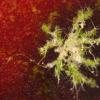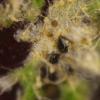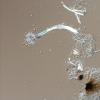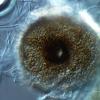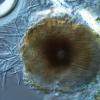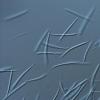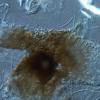
21-01-2026 16:32
Gernot FriebesHi,I need your help with some black dots on a lich

21-01-2026 16:48
Gernot FriebesHi,after my last unknown hyphomycete on this subst

20-01-2026 17:49
 Hardware Tony
Hardware Tony
I offer this collection as a possibility only as e

15-01-2026 15:55
 Lothar Krieglsteiner
Lothar Krieglsteiner
this one is especially interesting for me because

17-01-2026 19:35
Arnold BüschlenHallo, ich suche zu Cosmospora aurantiicola Lite

16-01-2026 00:45
Ethan CrensonHi all, On decorticated hardwood from a New York

18-01-2026 12:24
Hello.An anamorph located on the surface of a thin
Phyllocharis orbicularis
Roo Vandegrift,
28-09-2022 22:03
 Hello! I wanted to share a fascinating thing I saw this week. This is the coelomycete anamorph state of pyrenolichen Phyllocharis orbicularis (=Strigula orbicularis), which is apparently not illustrated anywhere. I was lucky enough to be able to ask Robert Lücking for help, and he ID'd it right away, having seen it before; when I asked where I could find an illustration, he admitted that he didn't think one existed, only the ascomata and the macromorphology of the thallus. The thallus of this particular example is somewhat poorly lichenized, and looks more like the photobiont (Cephaleuros virescens) than the typical thallus, but the conidia are the really fun part anyway.
Hello! I wanted to share a fascinating thing I saw this week. This is the coelomycete anamorph state of pyrenolichen Phyllocharis orbicularis (=Strigula orbicularis), which is apparently not illustrated anywhere. I was lucky enough to be able to ask Robert Lücking for help, and he ID'd it right away, having seen it before; when I asked where I could find an illustration, he admitted that he didn't think one existed, only the ascomata and the macromorphology of the thallus. The thallus of this particular example is somewhat poorly lichenized, and looks more like the photobiont (Cephaleuros virescens) than the typical thallus, but the conidia are the really fun part anyway.The conidia are hyaline, 4- to 6-septate, 40-45 x 2-3.5 ?m excluding the appendages, with a non-cellular, mucoid appendage at each end, which are quite variable in length, but generally less than 10 ?m, and often curving into a hook. Conidiophores are small, lageniform, reduced to conidiogenous cells, and integrated into the inner wall of the pycnidium.
I really wanted to put these photos out there, so that if anyone else is struggling to identify this beautiful and distinctive anamorph they'll be able to find some reference images! I can't thank Dr. Lücking enough for his kind help in the identification of this fungus.

